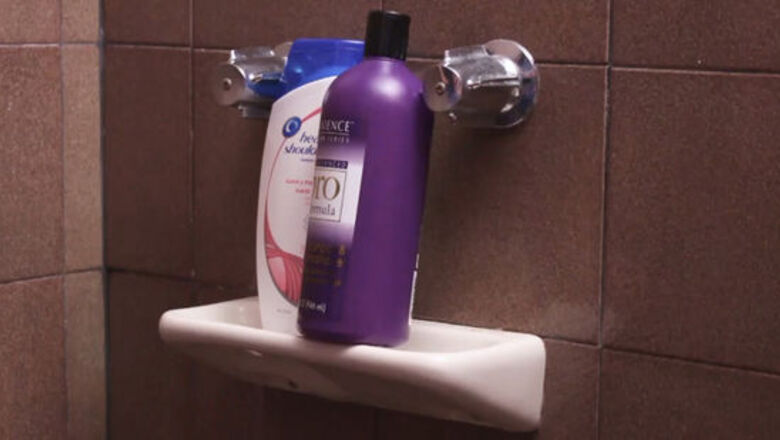
views
How to Clean a Bathroom
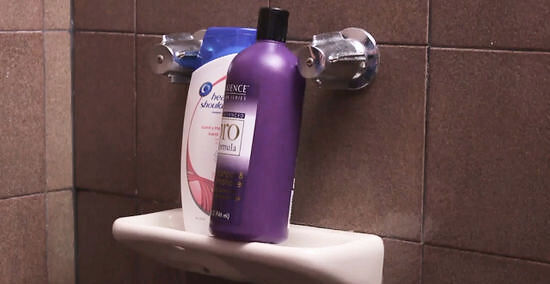
Clear off surfaces and remove items that don’t belong in the bathroom. Remove shampoo and conditioner from your shower, take your toothpaste and toothbrush off the sink, and clear off anything else that would prevent you from properly cleaning the surfaces in your bathroom. If you find something that doesn’t belong in the bathroom, put it in its proper location. Move any side tables or movable storage cabinets so you can clean under them, as well. Remember, the floor counts as a surface, so move any trash cans and bathmats, too.
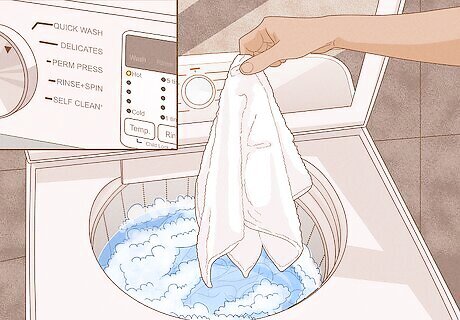
Launder towels, washcloths, and rugs. Gather any dirty towels, washcloths, and machine-washable bathmats, and launder them according to their care label; usually, towels should be washed on a cold, delicate cycle to keep them nice and fluffy. This way, they’ll be washed while you’re working on the bathroom, so they’ll be nice and clean when you get done. Wipe down in-tub bathmats with some soap and water and set them aside to air dry while you work.
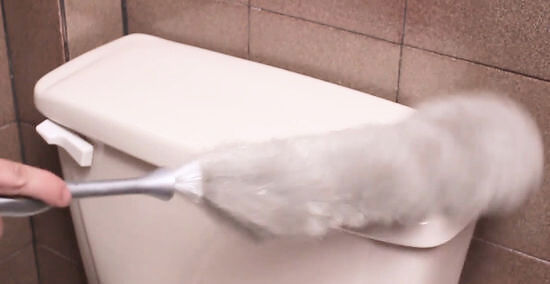
Dust and vacuum from top to bottom. Using a duster or microfiber cloth, begin dusting all surfaces from the top of your bathroom down. This includes your light fixtures, windows and blinds, countertops, the outside of your toilet, and the baseboards. Vacuum any bathmats or rugs to remove excess dust and debris.
Apply glass cleaner to glass, mirrors, and faucets. Lightly mist any mirrors, glass surfaces, and faucets with a glass cleaner. Then, wipe them down with a microfiber cloth or another lint-free material, like an old T-shirt. Flip the cloth to the other side to buff the surface to a dry shine. Use a small scrub brush to clean the crevices of your faucets and other fixtures. A 50:50 mixture of vinegar and water also works well to clean glass and other surfaces. Alternatively, use a squeegee on glass surfaces to keep them streak-free. Wear rubber gloves while you're cleaning to keep your hands from drying out if you're using harsh products. If your mirror is particularly cloudy, cleaning expert Filip Boksa says, “The easiest way to clean a cloudy mirror is to fill a spray-bottle with white vinegar and apply it to the glass. Wipe off the vinegar with a lint-free rag for a perfect finish. Be careful not to spray vinegar onto the wooden frame if present.”
Scrub the sink and counters. Use a small amount of all-purpose cleaner to scrub all the soap scum and toothpaste from your sink and counters, rinsing your sponge thoroughly as you go along. An old toothbrush or cotton swab can be handy for cleaning the gunk out from between the tap and handles of your sink. Now is also the time to clean any countertop items, like soap dispensers, toilet paper holders, and toothbrush holders. Wipe off the fronts and tops of cabinets and drawers, as well, using hot, soapy water. If you’re worried about germs on these surfaces, add a bit of bleach to your soapy water. Clean your counters before your sink, as you may knock dirt and debris into the sink as you work. If your sink is ceramic, cleaning expert Susan Stocker suggests using baking soda to clean it: “Make sure you get it mixed with enough water to make a paste or it’s not going to work—it requires the power of scrubbing just as much as it requires the power of baking soda. [Baking soda] has just the right amount of abrasive power to lift and remove dirt and grease, but it is not going to remove stubborn stains.”
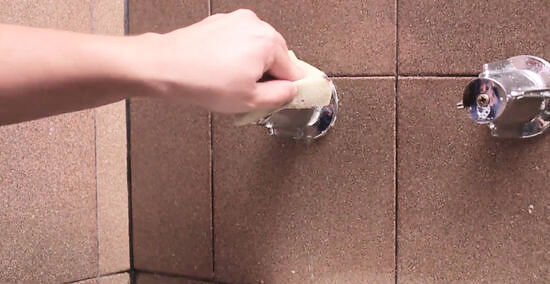
Scrub the bathtub and/or shower. Spray a shower cleaner or all-purpose cleaner on the shower walls and shower head, and let it sit for a few minutes before wiping it away. Apply a soap scum remover to your tub following the product’s instructions, and use a scrub brush to clean the surface, working from the outer rim of the tub down to the drain. Rinse everything well to remove any remaining dirt or cleaning product residue. If you have hard water or your tub is prone to lime or rust stains, opt for a calcium, lime, and rust remover. Never use abrasive cleaners, scrub pads, or steel wool on porcelain fixtures, as they will quickly dull the finish.
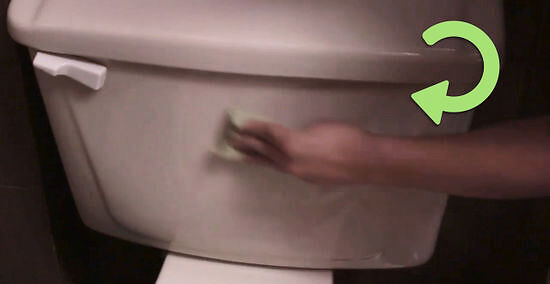
Clean the outside of the toilet. Soak a cloth in a disinfectant cleaner and wipe all around the outside of the toilet, starting with the flush handle and working your way down. Work from the least dirty to the dirtiest parts of the toilet so you don’t recontaminate anything. Thoroughly wash and rinse all exterior surfaces of the toilet, including the underside and flared base, the top and underside of the seat and lid, and the hinges and their mounting area. Do not clean the sink or any other surfaces with the same rag or paper towel you used to clean the toilet. This can spread leftover disease-causing germs to your sink. To prevent this, keep a specific rag that you only use to clean the toilet. If you use paper towels to clean the toilet (or any other surface), throw them away rather than flushing them.
Scrub the inside of the toilet with a toilet brush. Squirt some toilet cleaner (or sprinkle some baking soda) inside the rim and bowl of your toilet and scrub it with a toilet brush to remove any stains. Then, flush the toilet to remove any remaining dirt and cleaning residue. If the toilet is particularly dirty or stained, allow the cleaner to soak for at least half an hour before scrubbing. If you have hard water stains in the toilet bowl, dip a pumice stone in water and scrub the stains gently to remove them. For large, tough stains, cleaning expert Eduardo Peralta says, “Apply [an acidic toilet bowl cleaner] to the entire bowl of the toilet and let sit for about 10 minutes, then scrub [with a toilet brush] and flush to rinse. Apply bleach spray to the entire toilet bowl, let sit for 5 minutes, then use pumice to give it a good hard scrub. A magic eraser may be used as well to brighten the area.”
Sweep and mop the floor. If you haven’t already, give your baseboards a quick wipe-down. Sweep up all the dust and debris from the floor, then mop the floor using hot, soapy water mixed with a little bit of bleach. Be sure to get along the sides of your toilet bowl where it’s anchored to the floor, as this area is notoriously dirty. When you’re done, rinse the floor with clean water to remove slippery soap residue. When using bleach, Peralta says, “Always use protective eyewear, gloves, and [a] mask. I highly recommend opening windows, and never mix bleach with anything other than water, as this may cause chemical burns and dangerous fumes.”
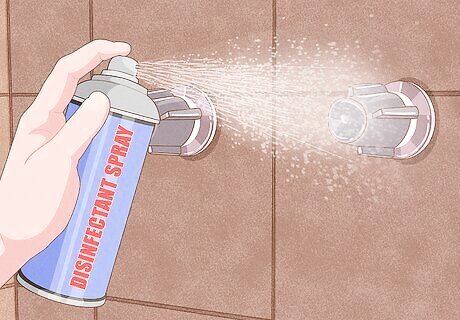
Disinfect high-touch areas. Only disinfect surfaces once you’ve finished cleaning. Apply disinfectant spray to areas that are touched frequently or are especially dirty, like cabinet and faucet handles, door knobs, and the toilet seat and handle. Use disinfecting wipes to wipe anywhere there’s been oversplash on the floor or walls near the toilet.
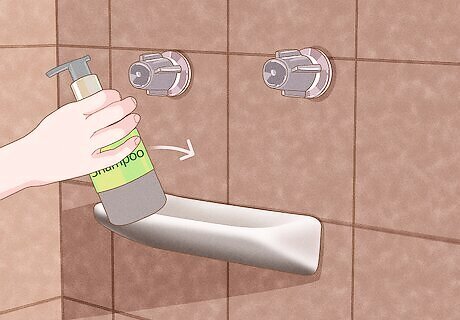
Restock and reorganize your bathroom. Once everything has been cleaned, go ahead and put things like shampoo, toothpaste, and bathmats back where they belong. This is also a good time to empty the bathroom trash can, refill soap dispensers, and make sure toilet paper and other necessities are well-stocked.
How to Deep Clean Your Bathroom
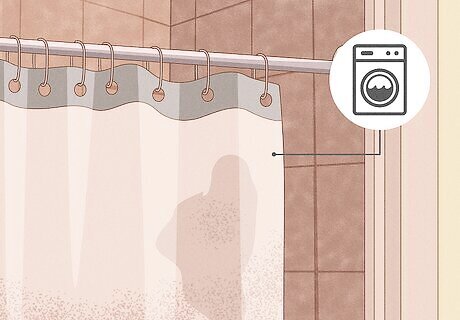
Wash your shower curtains and liners. Because they’re exposed to moisture, shower curtains and liners can become moldy and full of bacteria. While you don’t have to wash them every time you clean your shower, aim to clean them at least once a month. In general, wash your shower curtain (plastic or fabric) in the washing machine, but check the manufacturer’s instructions to be sure.
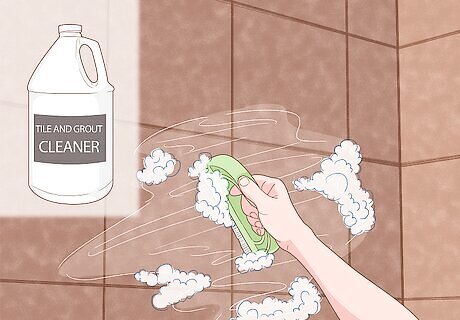
Scrub tile and grout. Depending on the conditions of your bathroom, it’s best to scrub tile every month or so, while grout only needs to be cleaned 3 or 4 times a year. Scrub your tile with your preferred tile and grout cleaner, and dip a grout brush into bleach to clean any discolored areas. Turn on your exhaust fan and leave the bathroom door open to keep the room ventilated. Seal grout every 6 months to prevent moisture and grime from seeping into it. EXPERT TIP Filip Boksa Filip Boksa House Cleaning Professional Filip Boksa is a House Cleaning Professional and the CEO and Founder of King of Maids, a company based in Chicago, Illinois. With over 10 years of professional experience, Filip and his team at King Maids specialize in providing home cleaning and organization services to their clients. They are dedicated to delivering high-quality and reliable service to ensure customer satisfaction. Filip Boksa Filip Boksa House Cleaning Professional Clean tile grout with a hydrogen peroxide solution. Create a solution of 1/2 cup baking soda, 1/4 cup hydrogen peroxide, and 1 tsp of dish soap. Apply this mixture to the grout and allow it to sit for 5-10 minutes. Use a grout brush to scrub the mixture into any cracks, then rinse with clean water.
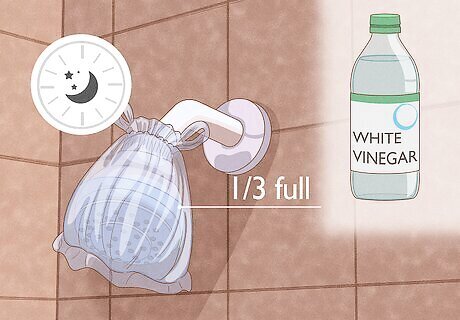
Descale your showerhead. If it seems like your showerhead is clogged, it’s probably time to descale it with vinegar. Fill a plastic bag about a third of the way full with distilled white vinegar and water. Use rubber bands to attach it to your showerhead so it's submerged in the vinegar and let it sit overnight. The next day, remove the bag, scrub the water holes with an old toothbrush to remove any remaining build-up, then run water through the showerhead. Alternatively, remove your showerhead and soak it in a bowl of vinegar overnight.
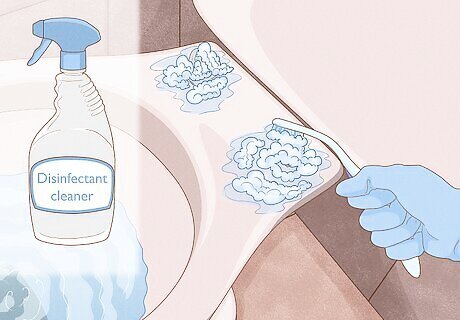
Clean under the toilet hinges. Dirt and debris easily get trapped in the toilet hinges, and while it’s possible to remove some of it by cleaning around the hinges, you’ll need to remove the seat completely to deep clean the area. After removing the seat, spray the hinges with a disinfectant cleaner and use an old toothbrush to scrub the crevices. If your hinges have removable caps, take them off for a deeper clean.
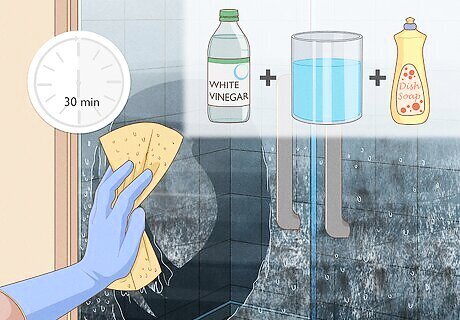
Remove soap scum. Cleaning your bathroom regularly should help prevent soap scum, but if it's built up, make a cleaning solution of distilled white vinegar, warm water, and a squirt of dish soap. Spray or wipe it over glass shower doors or any other surface that has soap scum. Let it sit for about half an hour, then wipe it away. Finish up with a glass cleaner to remove any remaining streaks.
Keeping the Bathroom Clean
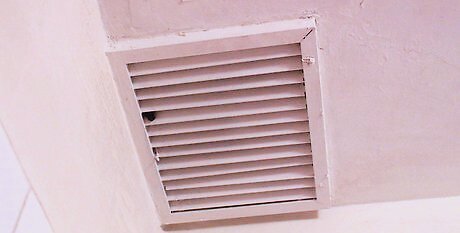
Run the exhaust fan in your bathroom. Keeping your bathroom ventilated discourages the growth of mildew, keeping your big cleaning sessions few and far between. Always run the ventilation fan after you get out of the shower to dry out the bathroom and keep the moisture from clinging. Aim to clean your exhaust fan every 6 months. Take it apart, vacuum out the inside of it, and soak the blade in a 50:50 mixture of vinegar and water. Then, wipe down the blade and cover. This will ensure that the fan is working at full capacity.
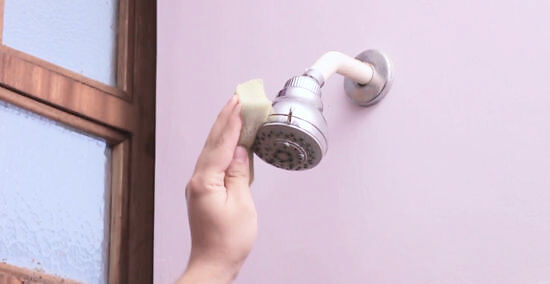
Wipe down the shower after you use it. To prevent and remove mold and mildew, wipe your bathtub and shower down every time you take a shower to remove excess moisture. Combined with running the fan, this should keep your bathroom mildew-free.
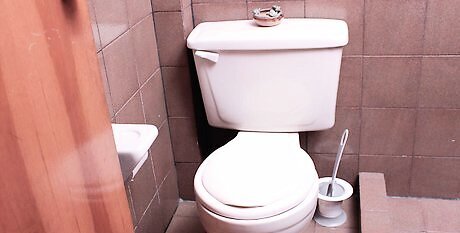
Keep the bathroom tidy and clutter-free. Much of what we call “mess” is really just clutter. If clothes accumulate in your bathroom, put a hamper or even a cardboard box in the room to collect dirty laundry. Use a toothbrush holder or a cup to keep your toothbrushes in order, and store other supplies in an old shoebox under the sink to keep the surface tidy.
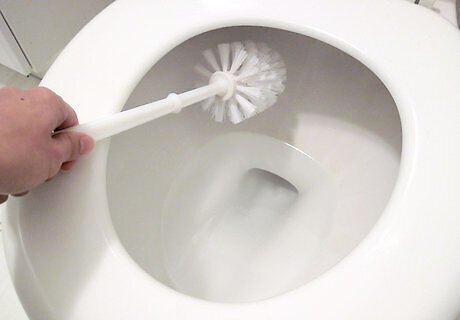
Scrub the toilet regularly. Even if it doesn’t look dirty, minerals in the water can stain the toilet bowl, so it’s a good idea to scrub the toilet down with a sturdy toilet brush regularly. If you do this even just once a week, your bigger cleanings will be much easier and less frequent.
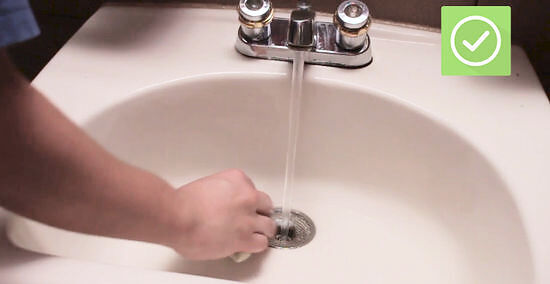
Wash toothpaste down the drain. Toothpaste stains and build-up in the sink and on the mirror can make a bathroom look dirtier than it needs to be. Clean up after brushing your teeth by washing the toothpaste down the drain and rinsing the sink out. Dry the bowl of the sink when you’re finished. To consolidate tasks, do this while you mouthwash for an added dental benefit.
Best Product Recommendations for Cleaning a Bathroom
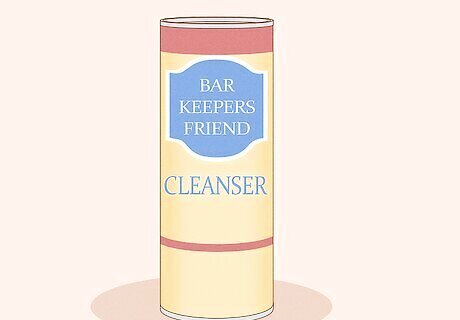
Bar Keepers Friend Bar Keepers Friend is a popular powder-based cleaner used to clean and polish many surfaces, effectively removing rust, tarnish, mineral deposits, and tough stains. Apply it to most surfaces in your bathroom, including sinks, tubs, faucets, showers, toilets, tile, and grout.
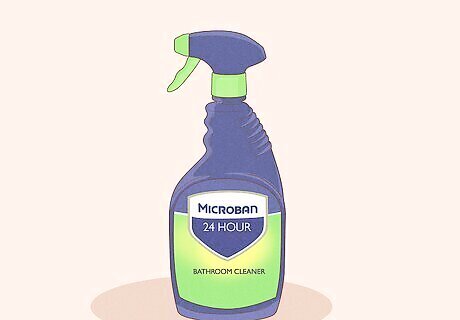
Microban 24 Hour Bathroom Cleaner Microban 24 Hour Bathroom Cleaner quickly cleans most surfaces and keeps them bacteria-free for 24 hours, even after they’ve been touched. This cleaner keeps mold and mildew at bay for 7 days, cuts through soap scum, and protects against cold, flu, and SARS-CoV-2 viruses. It’s also bleach-free.
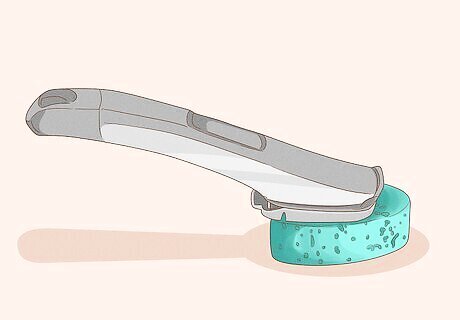
Scotch-Brite Swift Scrub Tub & Shower Wand The Scotch-Brite Swift Scrub Tub & Shower Wand has a versatile design that allows you to clean walls, tubs, shelves, glass, and more. Simply fill it with your preferred cleaner and get to work—it’s unlikely to drip. The handle is short compared to other shower wands, so it may be difficult to reach certain places.
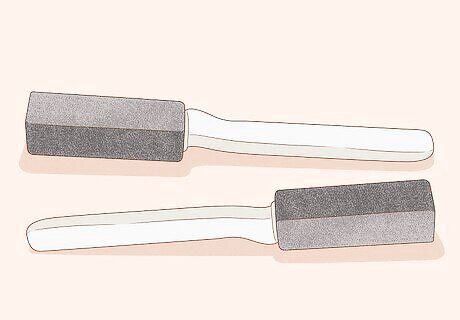
Powerstone Pumice Stone Toilet Bowl Cleaner The Powerstone Pumice Stone Toilet Bowl Cleaner with Handle effectively removes rings and calcium build-up from your toilet without scratching the bowl. Simply wet the stone, then lightly scrub the toilet until the stains are removed. Follow up with a disinfectant product to kill germs.










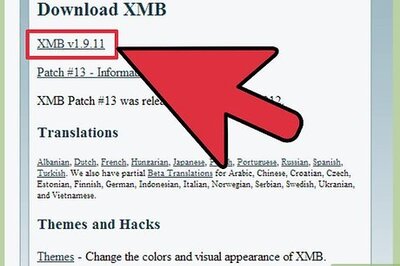







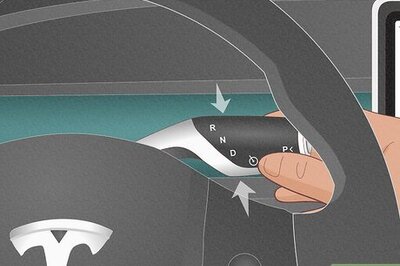
Comments
0 comment